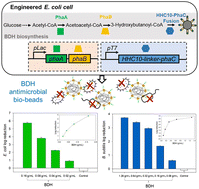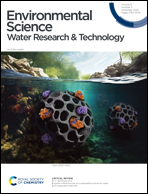Antimicrobial peptide-functionalized polyhydroxyalkanoate bio-beads as a bactericidal material for water disinfection†
Abstract
Waterborne diseases are a major public health concern worldwide. Water disinfection is being revolutionized by a new generation of technologies which aim to be effective in inactivating pathogens with minimum chemical and energy input and low risk to the ecosystem and human health. In this study, we created a new bactericidal material by expressing and displaying an antimicrobial peptide HHC10 on the surface of polyhydroxyalkanoate (PHA) bio-beads using synthetic biology. The material, named as bio-beads displayed HHC10 (BDH), had antimicrobial activity against Escherichia coli and Bacillus subtilis with reduction efficiencies of up to 6 log and 4 log, respectively. BDH retained 88% of the initial antimicrobial activity after 35 days storage, while the activity of free HHC10 peptide declined to 61%. BDH was effective in removing E. coli and B. subtilis in real-world surface water samples and had higher bacterial reduction efficiency than that in PBS buffer. Experimental results provided evidence that ionic strength is a key factor affecting the antimicrobial activity of BDH. This study reports, for the first time, the development of antimicrobial peptide-functionalized bio-beads as an effective bactericidal material, which can contribute to the development of future biomaterial-based technology for water disinfection.

- This article is part of the themed collection: Environmental Science: Water Research & Technology Hot Papers


 Please wait while we load your content...
Please wait while we load your content...